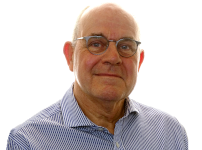

Simon Bartle, Visual Arts Correspondent
Bill Brandt And Henry Moore: At The Hepworth, Wakefield
This exhibition explores the fascinating parallels of the works of photographer Bill Brandt (1904-1983) and sculptor Henry Moore (1898-1986).
The exhibition opens with the occasion they both met in 1942, when Brandt photographed Moore in his studio for an article in Lilliput magazine. That article put side by side the two artists' shelter pictures, and explored their affinity in terms of their visual repertoires.
The Lilliput magazine was accessed by millions of people during the Second World War, and it sought to present, and achieved a representation of the British people as stoically surviving a truly horrific ordeal.

Both artists centred their work on the poetic and romantic visualisations of the dire wartime events, and tried to reconcile the terrible experiences of war. The work of Brandt and Moore has to be understood as part of the whole visualisation of extraordinary times.
It is apposite that the exhibition should put together the genres of art, and photo documentary. The exhibition succeeds in making a virtue of the fact that these two ways of visualising the wartime experience are equally valid.
Whilst both artists draw on the same or similar subjects, the work of Brandt is centred firmly on the impoverished and struggling communities of the North of England. That contrasts with Moore's body of work on the same subject areas, which seeks to present an altogether more optimistic viewpoint.
This exhibition celebrates the two men's self evident differences, and demonstrates how their distinct styles serves to influence one another.

Moore's incredibly intense coal mining drawings, done in his father's coal mine in Castleford, firmly place the emphasis on the heroic struggle of the coal miners, who were such a pivotal part of the war effort. Whilst Moore gives prominence to the positives, he does not ignore the appalling restricted underground conditions in which the miners toiled.
Moore's body of work starkly contrasts with that of Bill Brandt who centres on the cramped family home conditions. There is no heroism in Brandt's depictions of the mining families, the deprivation that they endured are positioned front and centre.
The relationship between the two-dimensional and three-dimensional is not lost on either artist. Moore embraced photography because it was a means of presenting his work, and also it became part of his creative method.

The exhibition superbly demonstrates the creative process of Moore, which he explains as follows:
"I sometimes begin a drawing, with no preconceived problem to solve, with only a desire to use pencil and paper, and make lines, tones and shapes, with no conscious aim: but as my mind takes in what is so produced, a point arrives where some idea becomes conscious and crystallizes, and then a control and ordering begins to take place."
Moore strives not to achieve an accurate representation of a subject, but to portray it's living being, and as one critic, wrote of one of Moore's sculptures:
"I would go and talk to it. I wouldn't expect it to answer, because it is made of stone, but I know it would hear every word because it is a living thing."

One of the highlights of the exhibition is the wall size tapestry made from a Henry Moore sketch. You will not miss it, but take time out to just 'stand and stare.'
The work of Bill Brandt and Henry Moore is examined by the exhibition as both picture and objects. This is a deep and thought provoking exhibition. You need to be alert to the complex relationship between photography, and the primary works of art. The impact on the psyche of the viewer is shared between the actual piece, and the printed photograph. The two co-exist in tandem.
Also by Simon Bartle...
Pre-Raphaelite Knights: Reinventing The Medieval World At The Bowes MuseumTurner: Northern Exposure At The Mercer Art Gallery, HarrogateDora Maar: Tate ModernNorman Cornish: The Definitive Collection At The Bowes Museum, Co DurhamBarbara Hepworth: Musée Rodin, ParisFinally, we leave you with a thought for when you visit the exhibition. Could circumstances have thrown together two better artists, whose work converged to explore the themes of struggle, deprivation, heroism, and hope? We think not, but you decide for yourself. Endless curatorial energy, and dedication has interlinked the work of Brandt and Moore, and succeeds in firmly embedding their visions in your consciousness.
This is undoubtedly a must see exhibition.
The exhibition is organised by the Yale Center for British Art in partnership with The Hepworth Wakefield.
Bill Brandt / Henry Moore is supported by The Henry Moore Foundation, Hiscox, and The Hepworth Wakefield Contemporary Circle.
Now until 31 May 2020
The Hepworth Wakefield, Gallery Walk, Wakefield, West Yorkshire, WF1 5AW
Open daily, 10am – 5pm.
Entry to the exhibition is £8.25 (with gift aid) / Free for Members, Wakefield residents & under 16s: Concessions available.
https://hepworthwakefield.org/your-visit/
https://hepworthwakefield.org/whats-on/bill-brandt-henry-moore/